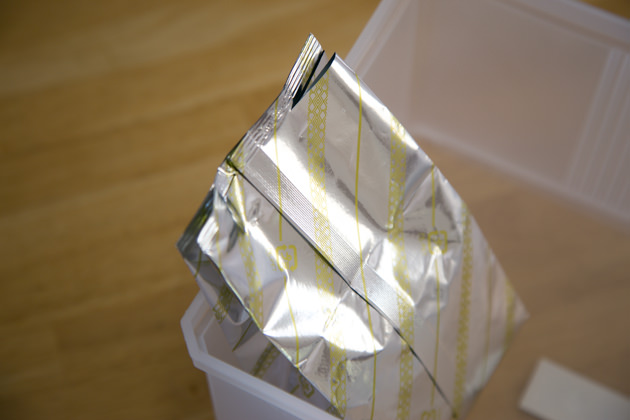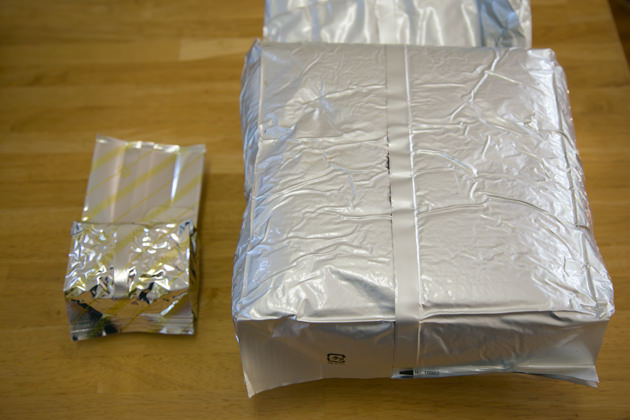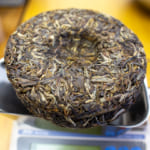- HOME >
- How to enjoy tea
“Decanting” of tea aged without oxygen
- [2017.09.20] Posted By Akira Hojo

We usually keep all types of tea without oxygen in order to retain its freshness. However, before start drinking the long-aged tea, you need to do something similar to “decanting” of wine in order to further enhance its fruitiness and sweetness in flavor.
We found that the ideal aging takes place if tea is kept without oxygen
A lot of people thought that if tea is kept without oxygen it will not age. In fact, when there is no oxygen, tea will age well. We conducted series of experiment and found that the tea flavor is ideal when tea is kept without oxygen.
The aging is an oxidative reaction. In chemistry, oxidation takes place even though there is no oxygen. In the definition of chemistry, receiving electron is also called oxidation, and this is exactly what happened when there is no oxygen inside the bag of tea. If tea is exposed, it changes very fast as oxidation is massively taking place. However, with excessive oxidation, in addition to maturation, the deterioration of tea takes place too at the same time. Tea will tend to develop earthy or musty flavor.
Long ago, pu-erh tea was compressed very tightly; it was named as “iron disc” as the compressed cake was as hard as a stone. It was compressed so tightly that I could hardly dismantle it. As those hard-compressed cakes contain no oxygen inside, it was matured exactly the same way as the tea aged without oxygen.
Aging works for all types of tea
In fact, it is not only pu-erh tea that undergoes aging. Based on our experience, any kinds of tea can age. We tested green tea, white tea, black tea, oolong tea or even flower tea. The only type of tea that is not suitable for aging is tea which contains very high amino acid/umami. If tea is grown with fertilizers, regardless of organic or chemical fertilizer, tea will be very rich in amino acid. After maturation, amino acid will develop fishy odor or dried squid smell due to Maillard reaction.
In general, tea with lower extent of fermentation is suitable for aging.
We need to treat tea just like we decant wine
Many of us know that vintage wine should be either decanted or we should open the cork earlier and leave it for a while before drinking. The purpose of decanting is to cause oxidation. After decanting, the flavor of wine will be awaken and become more floral or fruity note. Sometimes the flavor after the decanting is so different that it is hard for us to believe that we are drinking the same bottle of wine.
Likewise, we have to carry out the same method when we drink aged tea. After tea is being kept for more than a few years, it develops typical flavor like sweet potato or dried figs. As it lacks floral or fruity flavor, many of us tend to conclude that the aging is not sufficient or aging without oxygen is not ideal. However, if we leave it for a few days to a week, the flavor of tea will be literally “transformed”. If I open my own aged tea collection, I will make sure leave the bag open for more than a few days.

It is simple to get tea being “decanted”. I usually cut the bag as shown in the photo above or fasten it with clip after bag is fully opened.

Must avoid direct sunshine
By the way, letting tea exposed to moderate oxidation does not mean you can leave the tea under direct sunshine. The quality of tea will deteriorate fast once it is continuously being exposed to the sunshine. In addition, it is not necessary to repack tea into other container or bag. Certain type of material rather affect the taste of tea. So please keep tea in the original bag.
Related Articles
How to get the latest update on HOJO?
1. Follow Twitter, 2. Click "Like" on Facebook, and 3. Subscribe in newsletter. You can have the latest tea news from HOJO.
 Subscribe the Newsletter to enjoy the privileges
Subscribe the Newsletter to enjoy the privileges- You may receive a free sample upon purchase, or you may have the priority to purchase special products. So please remember to subscribe our newsletter as well as the social network.
- New Arrival of Akitsu Mumyoi and Nosaka Rough Clay Teapot
- A wide selection of teaware by Watanabe Tozo, a Sado-based artist of Mumyoi-yaki, has just arrived. This time, …
- Mang Fei Ripe Pu-erh Tea 2023 – Small-Batch Production from a Renowned Region
- Mang Fei Ripe Pu-erh Tea 2023 is now available. This is one of the highest-quality ripe pu-erh teas among our …
NEW ARTICLES
 Development of Firewood Roasted Hojicha Using Naturally Grown Tea from Yunnan
Development of Firewood Roasted Hojicha Using Naturally Grown Tea from Yunnan- We are currently staying in Yunnan Province for tea production. As the season nears its end, tea trees with pa …
 Exploring the Food Culture of Yunnan: Where Minority and Sichuan Cuisines Meet
Exploring the Food Culture of Yunnan: Where Minority and Sichuan Cuisines Meet- We are currently staying long-term in Yunnan Province for spring tea production. On rainy days or when there i …
 New Arrival of Akitsu Mumyoi and Nosaka Rough Clay Teapot
New Arrival of Akitsu Mumyoi and Nosaka Rough Clay Teapot- A wide selection of teaware by Watanabe Tozo, a Sado-based artist of Mumyoi-yaki, has just arrived. This time, …
 Managing Yunnan White Tea — Insights from the Field
Managing Yunnan White Tea — Insights from the Field- Since March 25, we have been in Yunnan Province, fully engaged in the production of white tea. In this column, …
 Mang Fei Ripe Pu-erh Tea 2023 – Small-Batch Production from a Renowned Region
Mang Fei Ripe Pu-erh Tea 2023 – Small-Batch Production from a Renowned Region- Mang Fei Ripe Pu-erh Tea 2023 is now available. This is one of the highest-quality ripe pu-erh teas among our …
 Yunnan Tea Trends 2025: Insights from the Fields
Yunnan Tea Trends 2025: Insights from the Fields- Since March 25, we have been in Yunnan Province. We will stay here until May to conduct tea production, packin …
 Why Do Some Teas Taste Astringent? Exploring the Causes and Mechanisms of Astringency
Why Do Some Teas Taste Astringent? Exploring the Causes and Mechanisms of Astringency- Tea can range from having no noticeable astringency to possessing a very strong one. What causes this astringe …
 The Impact of Heat Sources on Tea Flavor
The Impact of Heat Sources on Tea Flavor- It is widely recognized that the material of a kettle plays an important role in shaping the taste of water fo …
 New Release of Tang Li Shan Ripe Pu-erh Tea 2023
New Release of Tang Li Shan Ripe Pu-erh Tea 2023- We have released the 2023 edition of Tang Li Shan Ripe Pu-erh Tea. Tang Li Shan refers to a mountain located o …
 The New Release of Dong Shan Raw Pu-erh Tea 2023 and Jasmine Silver Needle
The New Release of Dong Shan Raw Pu-erh Tea 2023 and Jasmine Silver Needle- We have released Dong Shan Raw Pu-erh Tea 2023 and Jasmine Silver Needle. Dong Shan Raw Pu-erh Tea 2023 We hav …
Category
- New Arrival at HOJO Online Shop
- Featured Articles
- Newsletter
- Types of Tea
- Origin of Tea
- Teapot and Tea Equipment
- Tea Column
- How to enjoy tea
- Tea Processing
- How to choose quality tea
- Tea constituents and functional effect
- Safety of Tea
- Foods
- Tea Business Operation
- Hobby and Outdoor Activity
- Ranking of Tea
- Video
- FAQ
- Media Release
Profile

- AKIRA HOJO
- I invite you to experience my tea selections.I was born in Nagano, Japan. In university, I studied agricultural chemistry, and I have the master degree in food science. I worked in Japanese food industry for 10 years. I involved in R&D, QC and QA. As a factory manager, I implemented ISO9000 series and managed the factory.
- The Art of Tea Magazine
- We posted the article on “The Art of Tea Magazine No.9, the magazine is published in Taiwan. We featured …
- New Straits Times
- The Malaysian National Newspaper, New Straits Times featured HOJO Tea on 17-Oct-2007.
Shop Info

Address:Lot No. T-215, 3rd Floor, The Gardens Mall, Mid Valley City, Lingkaran Syed Putra, 59200 Kuala Lumpur
Tel: +603-2287-4537
Business Hour: 10am to 10pm


















